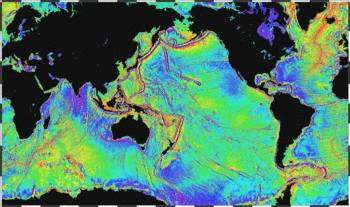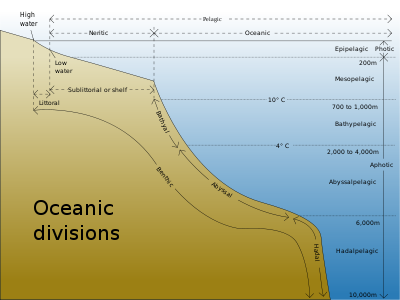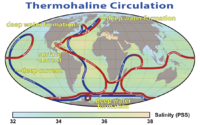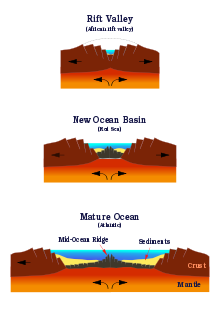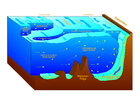- Ocean
-
For other uses, see Ocean (disambiguation).
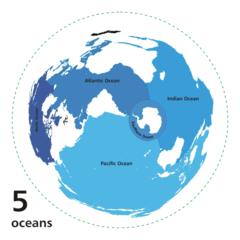 Maps exhibiting the world's oceanic waters. A continuous body of water encircling the Earth, the world (global) ocean is divided into a number of principal areas. Five oceanic divisions are usually recognized: Pacific, Atlantic, Indian, Arctic, and Southern; the last two listed are sometimes consolidated into the first three.
Maps exhibiting the world's oceanic waters. A continuous body of water encircling the Earth, the world (global) ocean is divided into a number of principal areas. Five oceanic divisions are usually recognized: Pacific, Atlantic, Indian, Arctic, and Southern; the last two listed are sometimes consolidated into the first three.

Earth's oceans
(World Ocean)An ocean (from Greek Ὠκεανὸς, "okeanos" Oceanus[1]) is a major body of saline water, and a principal component of the hydrosphere. Approximately 71% of the Earth's surface (~3.6×108 km2
) is covered by ocean, a continuous body of water that is customarily divided into several principal oceans and smaller seas.More than half of this area is over 3,000 metres (9,800 ft) deep. Average oceanic salinity is around 35 parts per thousand (‰) (3.5%), and nearly all seawater has a salinity in the range of 30 to 38 ‰. Scientists estimate that 230,000 marine species are currently known, but the total could be up to 10 times that number.[2]
Contents
Overview
Though generally described as several 'separate' oceans, these waters comprise one global, interconnected body of salt water sometimes referred to as the World Ocean or global ocean.[3][4] This concept of a continuous body of water with relatively free interchange among its parts is of fundamental importance to oceanography.[5]
The major oceanic divisions are defined in part by the continents, various archipelagos, and other criteria. These divisions are (in descending order of size):
- Pacific Ocean, which separates Asia and Australia from the Americas
- Atlantic Ocean, which separates the Americas from Europe and Africa
- Indian Ocean, which washes upon southern Asia and separates Africa and Australia
- Southern Ocean, sometimes considered an extension of the Pacific, Atlantic and Indian Oceans,[6] which encircles Antarctica.
- Arctic Ocean, sometimes considered a sea of the Atlantic, which covers much of the Arctic and washes upon northern North America and Eurasia.
The Pacific and Atlantic may be further subdivided by the equator into northern and southern portions. Smaller regions of the oceans are called seas, gulfs, bays, straits and other names.
Geologically, an ocean is an area of oceanic crust covered by water. Oceanic crust is the thin layer of solidified volcanic basalt that covers the Earth's mantle. Continental crust is thicker but less dense. From this perspective, the earth has three oceans: the World Ocean, the Caspian Sea[citation needed], and Black Sea. The latter two were formed by the collision of Cimmeria with Laurasia. The Mediterranean Sea is at times a discrete ocean, because tectonic plate movement has repeatedly broken its connection to the World Ocean through the Strait of Gibraltar. The Black Sea is connected to the Mediterranean through the Bosporus, but the Bosporus is a natural canal cut through continental rock some 7,000 years ago, rather than a piece of oceanic sea floor like the Strait of Gibraltar.
Despite their names, smaller landlocked bodies of saltwater that are not connected with the World Ocean, such as the Aral Sea, are actually salt lakes.
Borders of the oceans
For a detailed list of the borders of the oceans, see Borders of the oceans.
Ocean and life
The ocean has a significant effect on the biosphere. Oceanic evaporation, as a phase of the water cycle, is the source of most rainfall, and ocean temperatures determine climate and wind patterns that affect life on land. Life within the ocean evolved 3 billion years prior to life on land. Both the depth and distance from shore strongly influence the amount and kinds of plants and animals that live there.[7]
Physical properties
Further information: Sea waterThe area of the World Ocean is 361 million square kilometres (139 million square miles)[8] Its volume is approximately 1.3 billion cubic kilometres (310 million cu mi).[9] This can be thought of as a cube of water with an edge length of 1,111 kilometres (690 mi). Its average depth is 3,790 metres (12,430 ft), and its maximum depth is 10,923 metres (6.787 mi)[8] Nearly half of the world's marine waters are over 3,000 metres (9,800 ft) deep.[4] The vast expanses of deep ocean (anything below 200 metres (660 ft)) cover about 66% of the Earth's surface.[10] This does not include seas not connected to the World Ocean, such as the Caspian Sea.
The total mass of the hydrosphere is about 1,400,000,000,000,000,000 metric tons (1.5×1018 short tons) or 1.4×1021 kg, which is about 0.023 percent of the Earth's total mass. Less than 3 percent is freshwater; the rest is saltwater, mostly in the ocean.
Color
Main article: Color of waterA common misconception is that the oceans are blue primarily because the sky is blue. In fact, water has a very slight blue color that can only be seen in large volumes. While the sky's reflection does contribute to the blue appearance of the surface, it is not the primary cause.[11][dubious ] The primary cause is the absorption by the water molecules of red photons from the incoming light, the only known example of color in nature resulting from vibrational, rather than electronic, dynamics.[12]
Glow
Sailors and other mariners have reported that the ocean often emits a visible glow, or luminescence, which extends for miles at night. In 2005, scientists announced that for the first time, they had obtained photographic evidence of this glow.[13] It may be caused by bioluminescence.[14][15][16]
Exploration
Main article: Ocean explorationOcean travel by boat dates back to prehistoric times, but only in modern times has extensive underwater travel become possible.
The deepest point in the ocean is the Mariana Trench, located in the Pacific Ocean near the Northern Mariana Islands. Its maximum depth has been estimated to be 10,971 metres (35,994 ft) (plus or minus 11 meters; see the Mariana Trench article for discussion of the various estimates of the maximum depth.) The British naval vessel, Challenger II surveyed the trench in 1951 and named the deepest part of the trench, the "Challenger Deep". In 1960, the Trieste successfully reached the bottom of the trench, manned by a crew of two men.
Much of the ocean bottom remains unexplored and unmapped. A global image of many underwater features larger than 10 kilometres (6.2 mi) was created in 1995 based on gravitational distortions of the nearby sea surface.[citation needed]
Regions and depths
Oceanographers divide the ocean into regions depending on physical and biological conditions of these areas. The pelagic zone includes all open ocean regions, and can be divided into further regions categorized by depth and light abundance. The photic zone covers the oceans from surface level to 200 metres down. This is the region where photosynthesis can occur and therefore is the most biodiverse. Since plants require photosynthesis, life found deeper than this must either rely on material sinking from above (see marine snow) or find another energy source; hydrothermal vents are the primary option in what is known as the aphotic zone (depths exceeding 200 m). The pelagic part of the photic zone is known as the epipelagic. The pelagic part of the aphotic zone can be further divided into regions that succeed each other vertically according to temperature.
The mesopelagic is the uppermost region. Its lowermost boundary is at a thermocline of 12 °C (54 °F), which, in the tropics generally lies at 700–1,000 metres (2,300–3,300 ft). Next is the bathypelagic lying between 10 and 4 °C (50 and 39 °F), typically between 700–1,000 metres (2,300–3,300 ft) and 2,000–4,000 metres (6,600–13,000 ft) Lying along the top of the abyssal plain is the abyssalpelagic, whose lower boundary lies at about 6,000 metres (20,000 ft). The last zone includes the deep trenches, and is known as the hadalpelagic. This lies between 6,000–11,000 metres (20,000–36,000 ft) and is the deepest oceanic zone.
Along with pelagic aphotic zones there are also benthic aphotic zones. These correspond to the three deepest zones of the deep-sea. The bathyal zone covers the continental slope down to about 4,000 metres (13,000 ft). The abyssal zone covers the abyssal plains between 4,000 and 6,000 m. Lastly, the hadal zone corresponds to the hadalpelagic zone which is found in the oceanic trenches.
The pelagic zone can also be split into two subregions, the neritic zone and the oceanic zone. The neritic encompasses the water mass directly above the continental shelves, while the oceanic zone includes all the completely open water. In contrast, the littoral zone covers the region between low and high tide and represents the transitional area between marine and terrestrial conditions. It is also known as the intertidal zone because it is the area where tide level affects the conditions of the region.
Geology
Main article: Marine geologyThe ocean floor spreads from mid-ocean ridges where two plates adjoin. Where two plates move towards each other, one plate subducts under another plate (oceanic or continental) leading to an oceanic trench.
Climate effects
Ocean currents greatly affect the Earth's climate by transferring heat from the tropics to the polar regions, and transferring warm or cold air and precipitation to coastal regions, where winds may carry them inland. Surface heat and freshwater fluxes create global density gradients that drive the thermohaline circulation part of large-scale ocean circulation. It plays an important role in supplying heat to the polar regions, and thus in sea ice regulation. Changes in the thermohaline circulation are thought to have significant impacts on the Earth's radiation budget. Insofar as the thermohaline circulation governs the rate at which deep waters reach the surface, it may also significantly influence atmospheric carbon dioxide concentrations.
For a discussion of the possibilities of changes to the thermohaline circulation under global warming, see shutdown of thermohaline circulation.
It is often stated that the thermohaline circulation is the primary reason that the climate of Western Europe is so temperate. An alternate hypothesis claims that this is largely incorrect, and that Europe is warm mostly because it lies downwind of an ocean basin, and because atmospheric waves bring warm air north from the subtropics.[17][18]
The Antarctic Circumpolar Current encircles that continent, influencing the area's climate and connecting currents in several oceans.
One of the most dramatic forms of weather occurs over the oceans: tropical cyclones (also called "typhoons" and "hurricanes" depending upon where the system forms).
Biology
Main article: Marine biologyLifeforms native to oceans include:
- Radiata
- Fish
- Cetacea such as whales, dolphins and porpoises,
- Cephalopods such as octopus and squid
- Crustaceans such as lobsters, clams, shrimp and krill
- Marine worms
- Plankton
- Echinoderms such as brittle stars, starfish, sea cucumbers and sand dollars.
Economy
The oceans are essential to transportation: most of the world's goods move by ship between the world's seaports.
Oceans are also the major supply source for the fishing industry. Some of the more major ones are shrimp, fish, crabs and lobster.
Ancient oceans
Continental drift continually reconfigures the oceans, joining and splitting bodies of water.[citation needed] Ancient oceans include:
- Bridge River Ocean, the ocean between the ancient Insular Islands and North America.
- Iapetus Ocean, the southern hemisphere ocean between Baltica and Avalonia.
- Panthalassa, the vast world ocean that surrounded the Pangaea supercontinent.
- Rheic Ocean
- Slide Mountain Ocean, the ocean between the ancient Intermontane Islands and North America.
- Tethys Ocean, the ocean between the ancient continents of Gondwana and Laurasia.
- Khanty Ocean, the ocean between Baltica and Siberia.
- Mirovia, the ocean that surrounded the Rodinia supercontinent.
- Paleo-Tethys Ocean, the ocean between Gondwana and the Hunic terranes.
- Poseidon Ocean
- Proto-Tethys Ocean
- Pan-African Ocean, the ocean that surrounded the Pannotia supercontinent.
- Superocean, the ocean that surrounds a global supercontinent.
- Ural Ocean, the ocean between Siberia and Baltica.
Extraterrestrial oceans
- See also Extraterrestrial liquid water
Earth is the only known planet with liquid water on its surface and is certainly the only one in our own solar system. However, a layer of liquid water thick enough to decouple the crust from the mantle is thought to be present under the surfaces of the moons Titan, Europa and, with less certainty, Callisto and Ganymede.[19] A similar magma ocean is thought to be present on Io. Geysers have been found on Saturn's moon Enceladus, though these may not involve bodies of liquid water. Other icy moons and trans-neptunian objects may also have internal oceans, or have once had internal oceans that have now frozen.[19] The planets Uranus and Neptune may also possess large oceans of liquid water under their thick atmospheres, though their internal structure is not well understood.
There is currently much debate over whether Mars once had an ocean in its northern hemisphere, and over what happened to it; recent findings by the Mars Exploration Rover mission indicate Mars had long-term standing water in at least one location, but its extent is not known.
Astronomers believe that Venus had liquid water and perhaps oceans in its very early history. If they existed, all later vanished via resurfacing.
Liquid hydrocarbons (not water) are thought to be present on the surface of Titan, though lakes may be a more accurate term. The Cassini–Huygens space mission initially discovered only what appeared to be dry lakebeds and empty river channels, suggesting that Titan had lost what surface liquids it might have had. Cassini's more recent fly-by of Titan offers radar images that strongly suggest hydrocarbon lakes near the colder polar regions. Titan is thought to have a subterranean water ocean under the ice and hydrocarbon mix that forms its outer crust.
Beyond the solar system, the planet Gliese 581 c is at the right distance from its sun to support liquid surface water. However, its greenhouse effect would make it too hot for oceans to exist on the surface. On Gliese 581 d the greenhouse effect may bring temperatures suitable for surface oceans. Astronomers dispute whether HD 209458 b has water vapour in its atmosphere. Gliese 436 b is believed to have "hot ice." Neither of these planets are cool enough for liquid water—but if water molecules exist there, they are also likely to be found on planets at a suitable temperature.[20] GJ 1214 b, detected by transit, found evidence that this planet has oceans made of exotic form of ice VII, making up 75% of all the planet's mass.[21]
Culture
The original concept of "ocean" goes back to notions of Mesopotamian and Indo-European mythology, imagining the world to be encircled by a great river. Okeanos in Greek, reflects the ancient Greek observation that a strong current flowed off Gibraltar and their subsequent assumption that it was a great river. (Compare also Samudra from Hindu mythology and Jörmungandr from Norse mythology.) The world was imagined to be enclosed by a celestial ocean above the heavens, and an ocean of the underworld below.
Artworks which depict maritime themes are known as marine art, a term which particularly applies to common styles of European painting of the 17th to 19th centuries.
See also
- European Atlas of the Seas
- International Maritime Organization
- United Nations Convention on the Law of the Sea
- Marine debris
- Marine pollution
- Ocean acidification
- Oceanography
- Oceans (2009 film)
- Ogyges
- Pelagic zone
- Polar seas
- Sea
- Sea level and sea level rise
- Sea salt
- Sea state
- Seawater
- Seven Seas
- Water
- World Ocean Atlas
- World Ocean Day
References
- ^ Ὠκεανός, Henry George Liddell, Robert Scott, A Greek–English Lexicon, at Perseus project
- ^ Drogin, Bob (October 24, 2003). "Census of Marine Life maps an ocean of species". Los Angeles Times. http://www.latimes.com/new/la-na-fish2-2009aug02,0,5785256.story?page=1&track=ntothtml. Retrieved August 18, 2009.[dead link]
- ^ "Ocean". The Columbia Encyclopedia. 2002. New York: Columbia University Press
- ^ a b "Distribution of land and water on the planet". UN Atlas of the Oceans
- ^ Spilhaus, Athelstan F. (July 1942). Maps of the whole world ocean. 32 (3). American Geographical Society. pp. 431–5.
- ^ "Limits of Oceans and Seas, 3rd edition". International Hydrographic Organization. 1953. http://www.iho-ohi.net/iho_pubs/standard/S-23/S23_1953.pdf. Retrieved 7 February 2010.
- ^ Biology: Concepts & Connections. Chapter 34: The Biosphere: An Introduction to Earth's Diverse Environment. (sec 34.7)
- ^ a b "The World's Oceans and Seas". The World's Oceans and Seas. Encarta. http://encarta.msn.com/media_461547746/The_World's_Oceans_and_Seas.html.
- ^ Qadri, Syed (2003). "Volume of Earth's Oceans". The Physics Factbook. http://hypertextbook.com/facts/2001/SyedQadri.shtml. Retrieved 2007-06-07.
- ^ Drazen, Jeffrey C.. "Deep-Sea Fishes". School of Ocean Earth Science and Technology, University of University of Hawaiʻi at M?noa. http://www.soest.hawaii.edu/oceanography/faculty/drazen/fishes.htm. Retrieved 2007-06-07.
- ^ BAD PHYSICS: Misconceptions spread by K-6 Grade School Textbooks. Amasci.com. Retrieved on 2011-09-21.
- ^ "Why is water blue?". Journal Chemical Education. 1994. p. 612. http://www.dartmouth.edu/~etrnsfer/water.htm.
- ^ Britt, Robert Roy (October 4, 2005). "Mystery Ocean Glow Confirmed in Satellite Photos". http://www.livescience.com/strangenews/051004_sea_glow.html.
- ^ 21 November 2005, Usa today: A glowing sea, courtesy of algae Quote: "...The water glowed green in the direction of the movement...A: Little microscopic creatures (called Lingulodinium polyedrum) that glow in the dark caused the alluring strange display that night..."
- ^ 05 October 2005, New Scientist: Sea's eerie glow seen from space Quote: "...The ancient mariners were right. Tales of "milky seas" that glow bluish-white at night and extend as far as the horizon have been spun by sailors for centuries. Now this eerie glow has been spotted from space....The glowing area spanned 15,400 square kilometres (5,900 sq mi), an area the size of Connecticut (Image: Steven D Miller, US Naval Research Laboratory)..."
- ^ NASA, DAAC Study: The Incredible Glowing Algae "...Each year, the North Atlantic Ocean announces springtime by producing “blooms” large enough to be seen from space. These explosive increases in microscopic marine algae, called phytoplankton, appear as sudden bright blossoms in satellite imagery..."
- ^ Seager, R. (2006). "The Source of Europe's Mild Climate". American Scientist. http://www.americanscientist.org/issues/feature/2006/4/the-source-of-europes-mild-climate.
- ^ Rhines and Hakkinen (2003). "Is the Oceanic Heat Transport in the North Atlantic Irrelevant to the Climate in Europe?". ASOF Newsletter. http://www.realclimate.org/Rhines_hakkinen_2003.pdf.
- ^ a b Hussmann, H.; Sohl, Frank; Spohn, Tilman (2006). "Subsurface oceans and deep interiors of medium-sized outer planet satellites and large trans-neptunian objects". Icarus 185 (1): 258–273. Bibcode 2006Icar..185..258H. doi:10.1016/j.icarus.2006.06.005. http://adsabs.harvard.edu/abs/2006Icar..185..258H.
- ^ Hot "ice" may cover recently discovered planet
- ^ David A. Aguilar (2009-12-16). "Astronomers Find Super-Earth Using Amateur, Off-the-Shelf Technology". Harvard-Smithsonian Center for Astrophysics. http://www.cfa.harvard.edu/news/2009/pr200924.html. Retrieved January 23, 2010.
Further reading
- Matthias Tomczak and J. Stuart Godfrey. 2003. Regional Oceanography: an Introduction. (see the site)
- "Origins of the oceans and continents". UN Atlas of the Oceans.
- Pope, F. 2009. From eternal darkness springs cast of angels and jellied jewels. in The Times. November 23. 2009 p. 16–17.
External links
- Oceans at the Open Directory Project
- National Oceanic and Atmospheric Administration
- Marine forecasts for any ocean point – Buoyweather is a helpful link for marine safety
- Council on Foreign Relations, Interactive Guide to Oceans Governance
- Smithsonian Ocean Portal
The Earth Continents Oceans Earth Natural environment Related articles Earth's oceans and seas Arctic Ocean - Amundsen Gulf
- Barents Sea
- Beaufort Sea
- Bering Strait
- Chukchi Sea
- East Siberian Sea
- Fram Strait
- Greenland Sea
- Gulf of Boothia
- Kara Sea
- Kara Strait
- Laptev Sea
- Lincoln Sea
- Prince Gustav Adolf Sea
- Pechora Sea
- Wandel Sea
- White Sea
Atlantic Ocean - Adriatic Sea
- Aegean Sea
- Alboran Sea
- Archipelago Sea
- Argentine Sea
- Baffin Bay
- Balearic Sea
- Baltic Sea
- Bay of Biscay
- Bay of Bothnia
- Bay of Campeche
- Bay of Fundy
- Black Sea
- Bothnian Sea
- Caribbean Sea
- Celtic Sea
- Davis Strait
- Denmark Strait
- English Channel
- Foxe Basin
- Greenland Sea
- Gulf of Bothnia
- Gulf of Finland
- Gulf of Lion
- Gulf of Guinea
- Gulf of Mexico
- Gulf of St. Lawrence
- Gulf of Venezuela
- Great Lakes
- Hudson Bay
- James Bay
- Ionian Sea
- Irish Sea
- Irminger Sea
- Labrador Sea
- Levantine Sea
- Libyan Sea
- Ligurian Sea
- Marmara Sea
- Mediterranean Sea
- Myrtoan Sea
- North Sea
- Norwegian Sea
- Saint Lawrence Seaway
- Sargasso Sea
- Sea of Åland
- Sea of Azov
- Sea of Crete
- Sea of the Hebrides
- Thracian Sea
- Tyrrhenian Sea
Indian Ocean Pacific Ocean - Arafura Sea
- Bali Sea
- Banda Sea
- Bering Sea
- Bismarck Sea
- Bohai Sea
- Bohol Sea
- Camotes Sea
- Celebes Sea
- Ceram Sea
- Chilean Sea
- Coral Sea
- East China Sea
- Flores Sea
- Gulf of Alaska
- Gulf of California
- Gulf of Carpentaria
- Gulf of Thailand
- Gulf of Tonkin
- Halmahera Sea
- Java Sea
- Koro Sea
- Makassar Strait
- Molucca Sea
- Moro Gulf
- Philippine Sea
- Salish Sea
- Savu Sea
- Sea of Japan
- Sea of Okhotsk
- Seto Inland Sea
- Sibuyan Sea
- Solomon Sea
- South China Sea
- Sulu Sea
- Tasman Sea
- Visayan Sea
- Yellow Sea
Southern Ocean - Amundsen Sea
- Bellingshausen Sea
- Cooperation Sea
- Cosmonauts Sea
- Davis Sea
- D'Urville Sea
- King Haakon VII Sea
- Lazarev Sea
- Riiser-Larsen Sea
- Mawson Sea
- Ross Sea
- Scotia Sea
- Somov Sea
- Weddell Sea
Landlocked seas Categories:- Oceans
- Oceanography
- Coastal and oceanic landforms
- Greek loanwords
Wikimedia Foundation. 2010.

